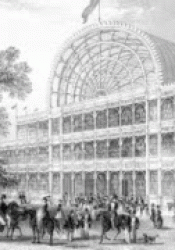The Great Exhibition
The Great Exhibition of the Works of Industry of all Nations, or the Great Exhibition for short, was an event that opened its doors on May 1, 1851. The Great Exhibition was brought about to showcase the “industry and ingeniousness of various world cultures” and to also educate the general public about the technologies that were on display (Audrey, para. 1). The majority of the exhibits that were shown had to deal with the British, about half or so, and the rest of the exhibits were set on display by other cultures.
The Great Exhibition was accessible from May to October of 1851. Queen Victoria opened this exhibition and held it in a structure that was built for this event – the Crystal Palace. The Crystal Palace was located in Hyde Park, London. The palace covered 26 acres and had over 4,000 tons of iron, over 200 miles of gutters and sash bars, and thousands and thousands of feet in wooden flooring as well as glass. The Crystal Palace resembled the “shopping arcades of Paris and London” (Audrey, para. 3). The entirety of the space was used to educate and entertain the public that wanted, and could afford, this exhibition experience.
The first day the Great Exhibition was opened, over 25,000 people attended. Overall, over six million came to the exhibition from May to October of 1851 and many of these guests attended the exhibition more than once (Queen Victoria included). When the doors first opened, the entrance fee was about five shillings or above. But as it became clear that the exhibition was vastly popular, the price was lowered to one shilling so that the entirety of the general population could attend. After this change was made, many feared that the general population would scare away the wealthier class, but the Great Exhibition was so popular that the numbers never even dropped!
Although this was a popular event and aimed to showcase the goods and technology of the time, no items were actually for sale in The Crystal Palace itself. The items were just there to showcase the new and upcoming things regarding goods and technology. The Great Exhibition steered the population towards window shopping and pushed the consumers towards consumption even though nothing was immediately for sale. The space that surrounded the population had them looking from object to object with nothing but admiration. The consumers were too dazzled by their environment to pay much attention to the idea that they wouldn’t immediately be able to leave with one of the lavishing items.
Jaffe, Audrey. “On the Great Exhibition.” BRANCH: Britain, Representation and Nineteenth-Century History. Ed. Dino Franco Felluga. Extension of Romanticism and Victorianism on the Net. Web. 25 October 2020.

